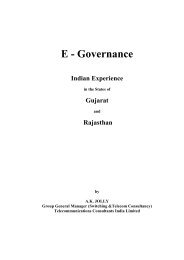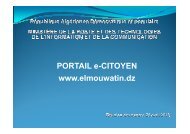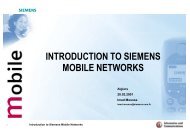5- S-CDMA FWA Overview - Ministère de la poste et des ...
5- S-CDMA FWA Overview - Ministère de la poste et des ...
5- S-CDMA FWA Overview - Ministère de la poste et des ...
You also want an ePaper? Increase the reach of your titles
YUMPU automatically turns print PDFs into web optimized ePapers that Google loves.
S-<strong>CDMA</strong> Fixed Wireless<br />
Access <strong>Overview</strong><br />
Presenter:<br />
Brian Bolon<br />
Director of Mark<strong>et</strong>ing<br />
L-3 PrimeWave Communications
S-<strong>CDMA</strong> Fixed Wireless Access <strong>Overview</strong><br />
<strong>Overview</strong> of S-<strong>CDMA</strong><br />
Comparison to Other <strong>FWA</strong><br />
Technologies<br />
Applications & Advantages<br />
–Circuit Switched Voice and Data<br />
–Pack<strong>et</strong> Switched Voice & Data<br />
–Intern<strong>et</strong> Access Implementations<br />
–Quality of Service and VoIP
What is S-<strong>CDMA</strong> <br />
Synchronous<br />
- Co<strong>de</strong><br />
Division<br />
Multiple<br />
Access<br />
–A Multiple<br />
Access<br />
Technique is a m<strong>et</strong>hod of<br />
merging multiple data streams into a single<br />
carrier<br />
–Co<strong>de</strong><br />
Division<br />
is a mo<strong>de</strong>rn Multiple Access<br />
Technique using PN co<strong>de</strong>s to spread data<br />
–Synchronous<br />
is an improvement to <strong>CDMA</strong><br />
which increases capacity and efficiency by<br />
using orthogonal co<strong>de</strong>s
Common <strong>FWA</strong> Multiple Access Techniques<br />
Fb<br />
TDMA<br />
Fb<br />
FDMA/OFDMA<br />
<strong>CDMA</strong><br />
User 1<br />
Cod<br />
e<br />
Frequency<br />
User 1<br />
Guard Band<br />
User 2<br />
Guard Band<br />
User 3<br />
Frequency<br />
Guard Band<br />
User 2<br />
Guard Band<br />
User 3<br />
Fa<br />
Fb<br />
User 1<br />
User 2<br />
Fa<br />
Time<br />
Fa<br />
Time<br />
User 3<br />
• Time Division Multiple<br />
Access<br />
• Divi<strong>de</strong>s a channel into<br />
time slices and transfers<br />
different sub-channels<br />
at different times<br />
• (Orthogonal)<br />
Frequency Division<br />
Multiple Access<br />
• Divi<strong>de</strong>s a channel<br />
into different subfrequencies<br />
and<br />
transmits subchannels<br />
at<br />
different<br />
frequencies<br />
• Co<strong>de</strong> Division Multiple<br />
Access<br />
• Spreads a sub-channel in<br />
frequency and time, use<br />
multiple PN co<strong>de</strong>s within<br />
same space
Impossible d'afficher l'image. Votre ordinateur<br />
manque peut-être <strong>de</strong> mémoire pour ouvrir<br />
l'image ou l'image est endommagée. Redémarrez<br />
l'ordinateur, puis ouvrez à nouveau le fichier. Si<br />
le x rouge est toujours affiché, vous <strong>de</strong>vrez peutêtre<br />
supprimer l'image avant <strong>de</strong> <strong>la</strong> réinsérer.<br />
Synchronizing the Forward Link in S-<strong>CDMA</strong><br />
The basestation adjusts its transmissions so that its signals<br />
arrive at all Subscribers at the same time.<br />
This synchronous timing, if used at the Chip and Symbol<br />
levels, allows all “Co<strong>de</strong>s” to be orthogonal to one another.<br />
Many <strong>CDMA</strong> systems employ this in the forward link.<br />
S1<br />
S2<br />
Time X & X’<br />
Subscriber<br />
S1<br />
Time Y<br />
S2<br />
Time Y<br />
Basestation<br />
Subscriber
Impossible d'afficher l'image. Votre ordinateur<br />
manque peut-être <strong>de</strong> mémoire pour ouvrir<br />
l'image ou l'image est endommagée. Redémarrez<br />
l'ordinateur, puis ouvrez à nouveau le fichier. Si<br />
le x rouge est toujours affiché, vous <strong>de</strong>vrez peutêtre<br />
supprimer l'image avant <strong>de</strong> <strong>la</strong> réinsérer.<br />
Synchronizing the Reverse Link in S-<strong>CDMA</strong><br />
Timing <strong>de</strong><strong>la</strong>y information is fed back from the basestation to<br />
each subscriber.<br />
All subscribers adjust their transmissions so that their<br />
signals arrive at the basestation at the same time.<br />
Few systems employ this in the reverse link.<br />
S1<br />
S2<br />
time<br />
Subscriber<br />
S1<br />
time<br />
S2<br />
time<br />
Basestation<br />
Subscriber
S-<strong>CDMA</strong> Permits Orthogonal PN Co<strong>de</strong>s<br />
By synchronizing at the chip and<br />
symbol level, , it is possible to use<br />
orthogonal spreading co<strong>de</strong>s.<br />
# of spreading co<strong>de</strong>s per carrier<br />
= “Processing Gain”<br />
Co<strong>de</strong> #1<br />
Orthogonality allows for the<br />
elimination of interference thus<br />
the capacity limitation is # of PN<br />
co<strong>de</strong>s (optimal)<br />
Co<strong>de</strong> #2<br />
L-3 PrimeWave’s PW-2000<br />
2000 has<br />
128 co<strong>de</strong>s per 3.5 MHz carrier in<br />
128 dimensional space<br />
Co<strong>de</strong> #3
So What does S-<strong>CDMA</strong> do for me<br />
S-<strong>CDMA</strong> is chip and symbol synchronous using orthogonal spreading<br />
co<strong>de</strong>s and offering co<strong>de</strong>-limited performance.<br />
– S-<strong>CDMA</strong> offers high fa<strong>de</strong> margins and avai<strong>la</strong>bilities far higher than<br />
comp<strong>et</strong>ing approaches<br />
– S-<strong>CDMA</strong> offers peak rates and system capacities that are among the best<br />
of comp<strong>et</strong>ing approaches<br />
– With lower frequency reuse, S-<strong>CDMA</strong> offers a b<strong>et</strong>ter spectral efficiency than<br />
other approaches<br />
– S-<strong>CDMA</strong> provi<strong>de</strong>s higher range cells than TDMA due to the ability to tra<strong>de</strong><br />
range for high data rates.<br />
– Equalization and diversity techniques allow S-<strong>CDMA</strong> to perform as well or<br />
b<strong>et</strong>ter in multipath environments than any other approach (including OFDM)<br />
– S-<strong>CDMA</strong> is more robust to jamming than non-spread spectrum comp<strong>et</strong>ing<br />
technologies.
S-<strong>CDMA</strong> Fixed Wireless Access <strong>Overview</strong><br />
<strong>Overview</strong> of S-<strong>CDMA</strong><br />
Comparison to Other <strong>FWA</strong><br />
Technologies<br />
Applications & Advantages<br />
–Circuit Switched Voice and Data<br />
–Pack<strong>et</strong> Switched Voice & Data<br />
–Intern<strong>et</strong> Access Implementations<br />
–Quality of Service and VoIP
Common <strong>FWA</strong> Multiple Access Techniques<br />
Fb<br />
TDMA<br />
Fb<br />
FDMA/OFDMA<br />
<strong>CDMA</strong><br />
User 1<br />
Cod<br />
e<br />
Frequency<br />
User 1<br />
Guard Band<br />
User 2<br />
Guard Band<br />
User 3<br />
Frequency<br />
Guard Band<br />
User 2<br />
Guard Band<br />
User 3<br />
Fa<br />
Fb<br />
User 1<br />
User 2<br />
Fa<br />
Time<br />
Fa<br />
Time<br />
User 3<br />
• Data bursted at peak<br />
system rate<br />
• Time-slot aggregation<br />
and/or increased slot<br />
duration for increased<br />
throughput<br />
• Low data rates in<br />
each frequency bin<br />
• Frequency bin<br />
aggregation and/or<br />
increased bin size<br />
for increased<br />
throughput<br />
• Low to mo<strong>de</strong>rate data<br />
rates in each <strong>CDMA</strong><br />
channel<br />
• <strong>CDMA</strong> channel<br />
aggregation for increased<br />
rate or reduced spreading<br />
factor for increased<br />
throughput
Orthogonal Multiplexing Schemes<br />
Orthogonal Frequency Division Multiplexing (OFDM)<br />
Total Data Rate = 4.096 Mbps<br />
• Carrier aggregation<br />
for high rate support.<br />
32 kbps 32 kbps 32 kbps 32 kbps<br />
f 1 f 2<br />
f 127<br />
f 128<br />
Frequency<br />
Total RF Bandwidth = 3.5 MHz<br />
Orthogonal Co<strong>de</strong> Division Multiplexing (OCDM)<br />
c 128<br />
Orthogonal<br />
Spreading<br />
Co<strong>de</strong>s<br />
c 2<br />
c 1<br />
Total Data Rate = 4.096 Mbps<br />
32 kbps<br />
32 kbps<br />
32 kbps<br />
f c<br />
Total RF Bandwidth = 3.5 MHz<br />
• Spreading Co<strong>de</strong><br />
aggregation for high<br />
rate support.<br />
• Multi-co<strong>de</strong> <strong>CDMA</strong><br />
• Multiple, robust<br />
lower rate channels.<br />
Frequency
Range vs Throughput (Assuming The Same Tx Amplifier)<br />
TDMA range is limited by the burst rate<br />
(true for either single-carrier or OFDM-based TDMA systems)<br />
4 Mbps<br />
4 Mbps<br />
<strong>CDMA</strong> can tra<strong>de</strong> range for rate in the reverse link<br />
4 Mbps<br />
4 Mbps<br />
2 Mbps<br />
512 kbps<br />
32 kbps
Reverse Link Capacity and Margin: A-<strong>CDMA</strong> vs. S-<strong>CDMA</strong><br />
Spreading Factor = 128<br />
E b /N 0 = 20 dB<br />
40<br />
35<br />
S-<strong>CDMA</strong>:<br />
Orthogonal Co<strong>de</strong>s<br />
with 40 dB of in-sector<br />
co<strong>de</strong> iso<strong>la</strong>tion<br />
Reverse Link SNR (dB)<br />
A-<strong>CDMA</strong>:<br />
15<br />
Non-orthogonal Co<strong>de</strong>s<br />
with 10 log10(128) = 21 dB<br />
10<br />
of in-sector co<strong>de</strong> iso<strong>la</strong>tion<br />
30<br />
25<br />
20<br />
5<br />
0<br />
Eb/Io (S-<strong>CDMA</strong>)<br />
Eb/No<br />
Eb/Io (A-<strong>CDMA</strong>)<br />
Eb/(Io+No) (A-<strong>CDMA</strong>)<br />
Eb/(Io+No) (S-<strong>CDMA</strong>)<br />
Margin against Fading,<br />
Jamming and Adjacent<br />
Cell/sector interference<br />
Typical threshold for<br />
QPSK and BER
Synchronous vs. Asynchronous <strong>CDMA</strong><br />
140<br />
120<br />
100<br />
80<br />
Number of Supported Channels per Sector<br />
(Processing Gain 128)<br />
60<br />
40<br />
20<br />
0<br />
Co<strong>de</strong> Limited Region<br />
Asynchronous<br />
<strong>CDMA</strong><br />
Synchronous<br />
<strong>CDMA</strong><br />
Interference<br />
Limited<br />
Region<br />
0 2 4 6 8 10 12 14<br />
Spreading Factor<br />
Of 128<br />
chips/symbol<br />
Fa<strong>de</strong> Margin (dB)<br />
Asynchronous <strong>CDMA</strong> is always<br />
interference limited and non-orthogonal<br />
co<strong>de</strong>s mean higher interference & lower capacity
Wire-line Quality Links Possible w/ S-<strong>CDMA</strong><br />
Synchronous <strong>CDMA</strong> permits<br />
– Co<strong>de</strong>-limited performance (high capacity)<br />
– High fa<strong>de</strong> margins and avai<strong>la</strong>bility<br />
– Wire-line quality service<br />
– Ability to tra<strong>de</strong> data rate for range<br />
Avai<strong>la</strong>bility (%)<br />
90<br />
99<br />
99.9<br />
99.99<br />
Fading Channel's<br />
Rice Factor<br />
k = 5<br />
k = 7.5<br />
k = 10<br />
0 5 10 15 20 25 30<br />
Fa<strong>de</strong> Margin (dB)<br />
Number of Supported Channels per Sector<br />
(Processing Gain 128)<br />
140<br />
120<br />
100<br />
80<br />
60<br />
40<br />
20<br />
Asynchronous<br />
<strong>CDMA</strong><br />
0<br />
0 2 4 6 8 10 12 14<br />
Fa<strong>de</strong> Margin (dB)<br />
Synchronous<br />
<strong>CDMA</strong>
Measuring Spectral Efficiency with S-<strong>CDMA</strong><br />
Spectral Efficiency – Per <strong>CDMA</strong> channel:<br />
– <strong>CDMA</strong> Data Rate / Spread Bandwidth<br />
– Typically low<br />
– E.g. 32 kbps / 3.5 MHz = 0.0091 bps/Hz<br />
Spectral Efficiency – Per SU Aggregate Channel:<br />
– SU Aggregate Data Rate / Spread Bandwidth<br />
– Low to mo<strong>de</strong>rate <strong>de</strong>pending on modu<strong>la</strong>tion and channel aggregation<br />
– E.g. 256 kbps / 3.5 MHz = 0.073 bps/Hz<br />
Spectral Efficiency – Iso<strong>la</strong>ted Cell:<br />
– Cell Capacity / Spread Bandwidth<br />
– Comparable to Single-carrier and multi-carrier TDMA approaches<br />
– E.g. 4.096 Mbps / 3.5 MHz = 1.1703 bps/Hz<br />
Spectral Efficiency – Multi-cell/multi<br />
cell/multi-sector:<br />
– Total System Capacity / Total Required RF Bandwidth / Number of Cells<br />
– Much b<strong>et</strong>ter than single-carrier and multi-carrier TDMA approaches<br />
– E.g. 4.096 / 3.5 = 1.1702 bps/Hz/cell (multi-cell, single-sector, sector, reuse =1)<br />
– E.g. 4.096 * 4 / (3.5 * 2) = 2.3406 bps/Hz/cell (multi-cell, four-sector, reuse=2)
Spectral Efficiency: S-<strong>CDMA</strong> vs. TDMA<br />
System<br />
Spectral<br />
Efficiency<br />
=<br />
Total System Capacity (bps)<br />
Required RF Bandwidth (Hz) × #Cells<br />
Co<strong>de</strong>-limited S-<strong>CDMA</strong><br />
Assuming No Guard Time,<br />
Pilots or Cyclic Preamble<br />
Spectral Efficiency<br />
S-<strong>CDMA</strong><br />
QPSK 16-QAM 64-QAM<br />
TDMA (OFDM or Single Carrier)<br />
Freq.<br />
Reuse QPSK 16-QAM 64-QAM<br />
Freq.<br />
Reuse<br />
Waveform<br />
(bits/sym) 2 4 6 NA 2 4 6 NA<br />
Single Cell (bps/Hz) 2 4 6 NA 2 4 6 NA<br />
Multi-cell w/ 1<br />
sector (bps/Hz/Cell) 2 4 6 1 0.5 1 2 4<br />
Multi-cell w/ 4<br />
sector (bps/Hz/Cell) 4 8 12 2 0.8 1.6 2.4 5<br />
* Suppose a 1M baud rate occupying an RF bandwidth of 1 MHz
PrimeWave 2000 vs. other technologies<br />
Prime Wave 2000<br />
IS-95<br />
GSM<br />
Other Synch <strong>CDMA</strong>s<br />
Core Technology Synch <strong>CDMA</strong> Async <strong>CDMA</strong> TDMA Synch <strong>CDMA</strong><br />
Frequency (MHz) 2100, 2200, 2600, 3500 800/1900 800/900/1800/1900 1300 - 3600<br />
Services POTS, Data, ISDN POTS POTS, Limited Data POTS, Data, ISDN<br />
RF Bandwidth 3.5 MHz 1.25 MHz 200 KHz 3.5 MHz<br />
Users/Carriers 100(128) @ 32 kb/s 45 4/8 52<br />
Spectral Efficiency<br />
(Bits/Sec/Hz)<br />
1.2 0.4 .13 (4x3 Freq Reuse) 0.68<br />
Bit Error Rate @ Cap. 10 -6 to 10<br />
-9<br />
Voice Coding Rate 32 and 64 Kbps 8/13 Kbps 4.8/13 Kbps 32 - 64 Kb/s ADPCM<br />
Voice Coding Type ADPCM and None QCELP ADPCM and None<br />
Voice Quality Score Wireline 2.7 Wireline<br />
Digital Data Rate 64, 128, and 256 Kbps 9.6 Kbps 32/64/512 Kbps<br />
Analog Mo<strong>de</strong>m Rate 56 Kbps 9.6 9.6 Kbps 56 Kbps
S-<strong>CDMA</strong> Fixed Wireless Access <strong>Overview</strong><br />
<strong>Overview</strong> of S-<strong>CDMA</strong><br />
Comparison to Other <strong>FWA</strong><br />
Technologies<br />
Applications & Advantages<br />
–Circuit Switched Voice and Data<br />
–Pack<strong>et</strong> Switched Voice & Data<br />
–Intern<strong>et</strong> Access Implementations<br />
–Quality of Service and VoIP
Circuit-Switching Versus Pack<strong>et</strong>-Switching<br />
Comp<strong>et</strong>itor's paradigm:<br />
– Carry both pack<strong>et</strong> and circuit-oriented services over pack<strong>et</strong> switched<br />
physical <strong>la</strong>yer<br />
OR<br />
– Carry both pack<strong>et</strong> and circuit-oriented services over a circuit-switched<br />
physical <strong>la</strong>yer<br />
PrimeWave's paradigm:<br />
– Use a physical <strong>la</strong>yer that has both circuit switched S-<strong>CDMA</strong> channels and<br />
pack<strong>et</strong> switched S-<strong>CDMA</strong> channels<br />
– Provi<strong>de</strong> each service with unique S-<strong>CDMA</strong> channels having the <strong>de</strong>sired<br />
<strong>la</strong>tency, jitter and bit error rate<br />
Providing circuit-switched services on a purely pack<strong>et</strong>-switched<br />
physical <strong>la</strong>yer leads to lower quality<br />
PrimeWave's circuit-switching quality will be maintained in the future
Circuit-Switched Telephony Application<br />
Analog<br />
Phones<br />
Fax<br />
Up to 8 discr<strong>et</strong>e<br />
tip and ring<br />
interfaces<br />
Intern<strong>et</strong><br />
POTS<br />
V.90 mo<strong>de</strong>m<br />
at 56 kbps<br />
SU<br />
PSTN<br />
SU<br />
ES4<br />
E1<br />
RBU<br />
NIU<br />
SU
V.35 Application<br />
Intern<strong>et</strong><br />
Router<br />
Router<br />
V.35<br />
SU<br />
ES4<br />
Router<br />
Or SMS<br />
E1 or 100BaseT<br />
NIU<br />
Rates up to 256 kbps in PW2K<br />
Rates up to 4.096 Mbps in PW4K<br />
RBU<br />
E1<br />
PSTN
Integrated Services Digital N<strong>et</strong>work (ISDN)<br />
ISDN provi<strong>de</strong>s circuit-switched<br />
data/voice service<br />
POTS<br />
64 kbps<br />
fax<br />
PSTN<br />
Intern<strong>et</strong><br />
Data<br />
Terminal<br />
ISDN<br />
PBX<br />
S/T<br />
Interface<br />
2B+D<br />
Rate only<br />
SU<br />
ES4<br />
ISDN<br />
central<br />
office<br />
E1<br />
ISDN<br />
Router/Bridge<br />
Ethern<strong>et</strong><br />
LAN<br />
SU<br />
RBU<br />
NIU
S-<strong>CDMA</strong> Fixed Wireless Access <strong>Overview</strong><br />
<strong>Overview</strong> of S-<strong>CDMA</strong><br />
Comparison to Other <strong>FWA</strong><br />
Technologies<br />
Applications & Advantages<br />
–Circuit Switched Voice and Data<br />
–Pack<strong>et</strong> Switched Voice & Data<br />
–Intern<strong>et</strong> Access Implementations<br />
–Quality of Service and VoIP
PrimeWave 2000 Data N<strong>et</strong>work Architecture<br />
10BaseT<br />
RJ-45<br />
Ethern<strong>et</strong><br />
SU<br />
Ethern<strong>et</strong><br />
LAN<br />
Ethern<strong>et</strong><br />
SU<br />
IP Router/<br />
Firewall<br />
IP Router/SMS/<br />
VoIP Gateway<br />
Ethern<strong>et</strong><br />
Hub/Bridge<br />
Ethern<strong>et</strong><br />
SU<br />
10BaseT<br />
RJ-45<br />
Intern<strong>et</strong><br />
POTS<br />
RJ-11<br />
VoIP<br />
Gateway/<br />
IP Router<br />
10BaseT<br />
RJ-45<br />
10BaseT<br />
RJ-45<br />
Ethern<strong>et</strong><br />
SU<br />
PrimeWave<br />
RBU<br />
E1<br />
PrimeWave<br />
NIU<br />
PSTN
PrimeWave 2000 Data N<strong>et</strong>work Architecture<br />
PrimeWave offers pack<strong>et</strong> data services using an Ethern<strong>et</strong><br />
10BaseT interface<br />
PrimeWave is a Wireless Ethern<strong>et</strong> Switch<br />
– Switch: A n<strong>et</strong>work <strong>de</strong>vice connecting multiple LANs that use i<strong>de</strong>ntical LAN<br />
protocols. The switch acts as an address filter, switching pack<strong>et</strong>s b<strong>et</strong>ween<br />
b<strong>et</strong>ween LANs without modifying the contents of the pack<strong>et</strong>s.<br />
IP<br />
Switch<br />
Switch<br />
IP<br />
<br />
Ethern<strong>et</strong>/<br />
IEEE<br />
802.3<br />
Ethern<strong>et</strong>/<br />
IEEE 802.3<br />
Ethern<strong>et</strong>/<br />
IEEE 802.3<br />
Ethern<strong>et</strong>/<br />
IEEE<br />
802.3<br />
<br />
<br />
10BaseT<br />
10BaseT<br />
Prime<br />
Wave<br />
PHY<br />
Prime<br />
Wave<br />
PHY<br />
10/<br />
100BaseT<br />
10/<br />
100BaseT<br />
<br />
Intern<strong>et</strong><br />
Or<br />
Local IP<br />
N<strong>et</strong>work<br />
PC or other<br />
IP-based<br />
LAN <strong>de</strong>vice<br />
PrimeWave<br />
SU<br />
PrimeWave<br />
RBU<br />
IP Router/SMS
Bandwidth Allocation and System Loading<br />
Light loading (Load < 25%)<br />
– Connect rate = Provisioned rate<br />
– Connection hold time = Long (60 seconds)<br />
Mo<strong>de</strong>rate Loading (25% < Load < 75%)<br />
– Connect rate = Provisioned rate<br />
– Connection hold time = Mo<strong>de</strong>rate (5 seconds)<br />
Heavy Loading (Load > 75%)<br />
– Connect rate = min{ Provisioned rate, 128 kbps }<br />
– Connection hold time = Short (2/3 seconds)<br />
Very Heavy Loading (Load > 90%)<br />
– Connect rate = min{ Provisioned rate, 64 kbps }<br />
– Connection hold time = Short (2/3 seconds)
S-<strong>CDMA</strong> Fixed Wireless Access <strong>Overview</strong><br />
<strong>Overview</strong> of S-<strong>CDMA</strong><br />
Comparison to Other <strong>FWA</strong><br />
Technologies<br />
Applications & Advantages<br />
–Circuit Switched Voice and Data<br />
–Pack<strong>et</strong> Switched Voice & Data<br />
–Intern<strong>et</strong> Access Implementations<br />
–Quality of Service and VoIP
Intern<strong>et</strong> Access Implementations<br />
IP Router-based:<br />
– IP Router connected to RBU<br />
– Configured for <strong>de</strong>sired QoS and n<strong>et</strong>work connectivity<br />
– Router may perform accounting and IP address<br />
management (e.g. NAT or DHCP)<br />
– Wireless authentication via PW2K<br />
– Users always on (e.g. no log-in)<br />
– An external <strong>de</strong>vice, such as the Allot<br />
N<strong>et</strong>Enforcer, could be used for enhanced QoS,<br />
accounting and billing features.<br />
– Perhaps cheaper than VPN approach<br />
– Cisco router vs. Redback SMS
Example: ISP using an IP Router<br />
Ethern<strong>et</strong>/<br />
802.3<br />
10/100BaseT<br />
Ethern<strong>et</strong>/<br />
802.3<br />
LAN<br />
SU<br />
Intern<strong>et</strong><br />
IP Router<br />
SU<br />
Ethern<strong>et</strong>/<br />
802.3<br />
10/100BaseT<br />
Ethern<strong>et</strong>/<br />
802.3<br />
10/100BaseT<br />
SU<br />
RBU<br />
IP Router<br />
(Cisco 2600)
Intern<strong>et</strong> Access Implementations<br />
VPN-based:<br />
– Layer 2 VPN (IEEE 802.1Q)<br />
– Layer 3 VPN (PPPoE, PPTP, L2TP or IPSec)<br />
– Requires Management <strong>de</strong>vice<br />
Advantages:<br />
– B<strong>et</strong>ter control of AAA (Accounting,<br />
Authorization and Authentication)<br />
– More secure<br />
– Industry standard for DSL, cable mo<strong>de</strong>ms, <strong>et</strong>c.
Example: Layer 2 VLAN using 802.1Q<br />
VLAN #N<br />
10BaseT<br />
SU<br />
Intern<strong>et</strong><br />
Or Local IP N<strong>et</strong>work<br />
VLAN #2<br />
10BaseT<br />
SU<br />
10BaseT<br />
VPN Access<br />
Concentrator<br />
VLAN #1<br />
10BaseT<br />
SU<br />
SU<br />
RBU #1<br />
10/100BaseT<br />
10/100BaseT<br />
Or<br />
ATM<br />
Or<br />
FR<br />
Ethern<strong>et</strong><br />
Switch<br />
10/100BaseT<br />
VLAN Aware<br />
Ethern<strong>et</strong><br />
Switch<br />
Ethern<strong>et</strong><br />
LAN<br />
10BaseT<br />
SU<br />
RBU #15<br />
NIU
Virtual Private N<strong>et</strong>working Using PW2K<br />
Layer 2 VPN:<br />
– Based on IEEE 802.1Q VLAN standard<br />
– Each SU has a VLAN i<strong>de</strong>ntifier which is inserted<br />
into every pack<strong>et</strong><br />
– RBU and SU are VLAN aware, switching<br />
pack<strong>et</strong>s based solely on VLAN ID<br />
– RBU can switch pack<strong>et</strong>s from SU-to-SU<br />
– Ability to <strong>de</strong>fine closed user groups based on<br />
VLAN Id (e.g. give multiple SUs the same VLAN<br />
ID)<br />
– Consi<strong>de</strong>red for future <strong>de</strong>velopment
Layer 3 VPN<br />
Use Layer 3 protocols including PPPoE, L2TP,<br />
PPTP and IPSec to create a secure VPN<br />
– Common m<strong>et</strong>hodology for DSL and Cable Mo<strong>de</strong>ms<br />
– Layer 2 transport is Ethern<strong>et</strong> carried over PW2K wireless<br />
air interface<br />
Requires a subscriber management system (SMS)<br />
or VPN Concentrator along with client software.<br />
– PPPoE Example:<br />
– Redback SMS 500 + WinPoET Client Software by Fine Point<br />
Technologies<br />
– PPTP/L2TP/IPSec Example:<br />
– Cisco 3060 VPN Concentrator + Cisco client Software<br />
Avai<strong>la</strong>ble today
Example: Layer 3 VPN Using PPPoE<br />
10BaseT<br />
10BaseT<br />
SU<br />
Intern<strong>et</strong><br />
Or Local IP N<strong>et</strong>work<br />
SU<br />
10BaseT<br />
SU<br />
10BaseT<br />
SU<br />
10/100BaseT<br />
Ethern<strong>et</strong> LAN<br />
Router<br />
RBU #1<br />
10/100BaseT<br />
Redback SMS 500<br />
NIU<br />
RBU #15
S-<strong>CDMA</strong> Fixed Wireless Access <strong>Overview</strong><br />
<strong>Overview</strong> of S-<strong>CDMA</strong><br />
Comparison to Other <strong>FWA</strong><br />
Technologies<br />
Applications & Advantages<br />
–Circuit Switched Voice and Data<br />
–Pack<strong>et</strong> Switched Voice & Data<br />
–Intern<strong>et</strong> Access Implementations<br />
–Quality of Service and VoIP
Pack<strong>et</strong>-Switched Voice (VoIP)<br />
Alternative to circuit-switched voice lines carried over IP using SIP<br />
or H.323<br />
Carried over Ethern<strong>et</strong> Interface in PrimeWave 2000<br />
Customers/operators can tra<strong>de</strong> quality for capacity<br />
– Variable compression from 6 kbps up to 64 kbps voice<br />
– Allow up to 3 times more simultaneous voice calls<br />
– Typical <strong>de</strong><strong>la</strong>ys up to 150 ms compared to 10 ms for circuit-switching<br />
Local Concentration at the SU<br />
– Access Concentrators convert Analog POTS lines to IP over Ethern<strong>et</strong><br />
Allows a single IP-based backbone n<strong>et</strong>work for voice and a data<br />
– Potential cost savings<br />
Supported today<br />
I<strong>de</strong>al for Apartment Buildings, Businesses
VoIP Using PrimeWave 2000<br />
Components<br />
– POP Gateways<br />
– Located at N<strong>et</strong>work Edge (e.g. RBU)<br />
– Responsible for call control, signalling and<br />
accounting<br />
– Responsible for interaction with PSTN or IP n<strong>et</strong>work<br />
– Resi<strong>de</strong>ntial Gateways<br />
– Located at SU<br />
– Allow concentration at the SU<br />
– User Devices:<br />
– Softphone and VoIP Phones<br />
– Companies:<br />
– Mediatrix, Oki, Cisco, <strong>et</strong>c.
Pack<strong>et</strong>-Switched Telephony Application<br />
Analog<br />
Phone/Fax<br />
802.3<br />
POTS (RJ-11)<br />
Mediatrix<br />
802.3<br />
LAN<br />
SU<br />
PSTN<br />
SU<br />
POTS (RJ-11)<br />
Router/Gateway<br />
w/ QoS<br />
10/100BaseT<br />
Cisco AS-8<br />
IP Phone/Fax<br />
802.3<br />
LAN<br />
RBU<br />
Router/<br />
VoIP Gateway<br />
Router/Gateway<br />
w/ QoS<br />
SU<br />
Intern<strong>et</strong>
Quality of Service<br />
PrimeWave offers QoS appropriate for both circuit<br />
and pack<strong>et</strong>-based applications<br />
Circuit-based QoS Criteria (e.g. telephony)<br />
– Avai<strong>la</strong>bility<br />
– Bit error rate<br />
– Latency<br />
– Voice quality<br />
Pack<strong>et</strong>-based QoS Criteria<br />
– Throughput or data rate<br />
– Bit or pack<strong>et</strong> error rate<br />
– Pack<strong>et</strong> jitter and <strong>la</strong>tency<br />
– Pack<strong>et</strong> prioritization and bandwidth reservation (for real-<br />
time applications)
Pack<strong>et</strong>-based QoS Today<br />
Pack<strong>et</strong>-based QoS<br />
– Nominal BER
Thank You<br />
Presenter:<br />
Brian Bolon<br />
Director of Mark<strong>et</strong>ing<br />
L-3 PrimeWave Communications
















